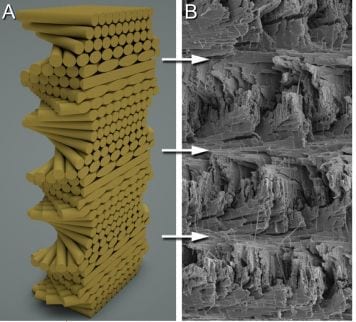
“Biology has an incredible diversity of species, which can provide us new design cues and synthetic routes to the next generation of advanced materials for light-weight automobiles, aircraft and other structural applications”
Inspired by mantis shrimp, researchers design composite material stronger than standard used in airplane frames
Inspired by the fist-like club of a mantis shrimp, a team of researchers led by University of California, Riverside, in collaboration with University of Southern California and Purdue University, have developed a design structure for composite materials that is more impact resistant and tougher than the standard used in airplanes.
“The more we study the club of this tiny crustacean, the more we realize its structure could improve so many things we use every day,” said David Kisailus, a Kavli Fellow of the National Academy of Science and the Winston Chung Endowed Chair of Energy Innovation at the UC Riverside’s Bourns College of Engineering.
The peacock mantis shrimp, or stomatopod, is a 4- to 6-inch-long rainbow-colored crustacean with a fist-like club that accelerates underwater faster than a 22-calibur bullet. Researchers, led by Kisailus, an associate professor of chemical engineering, are interested in the club because it can strike prey thousands of times without breaking.
The force created by the impact of the mantis shrimp’s club is more than 1,000 times its own weight. It’s so powerful that Kisailus needs to keep the animal in a special aquarium in his lab so it doesn’t break the glass. Also, the acceleration of the club creates cavitation, meaning it shears the water, literally boiling it, forming cavitation bubbles that implode, yielding a secondary impact on the mantis shrimp’s prey.
Previous work by the researchers, published in the journal Science in 2012, found the club is comprised of several regions, including an endocuticle region. This region is characterized by a spiraling arrangement of mineralized fiber layers that act as shock absorber. Each layer is rotated by a small angle from the layer below to eventually complete a 180-degree rotation.
In a paper “Bio-Inspired Impact Resistant Composites,” just published online in the journal Acta Biomaterialia, the researchers applied that spiraled, or helicoidal, layered design when creating carbon fiber-epoxy composites. Composites with this design structure could be used for a variety of applications, including aerospace and automotive frames, body armor and football helmets.
In experiments outlined in the paper, which were led by Lessa Grunenfelder, who formerly worked in Kisailus’ lab and is now a post-doctoral student at USC, carbon fiber-epoxy composites were created with layers at three different helicoidal angles ranging from about 10 degrees to 25 degrees.
They also built two control structures: a unidirectional, meaning the layers were placed directly on top and parallel to each other, and a quasi-isotropic, the standard used in the aerospace industry, which has alternating layers stacked upon each other in an orientation of 0 degrees (first layer), -45 degrees (second layer), +45 degrees (third layer), 90 degrees (fourth layer) and so on.
The goal was to examine the impact resistance and energy absorption of the helicoidal structures when they were struck and to quantify the strength after the impact.
The researchers used a drop weight impact testing system with a spherical tip that on impact creates 100 joules of energy at USC with their collaborator, Professor Steven R. Nutt. This replicates testing done by the aircraft industry. Following the tests, they measured external visual damage, depth of the dent and internal damage by using ultrasound scans.
The Latest on: Composite materials
[google_news title=”” keyword=”Composite materials” num_posts=”10″ blurb_length=”0″ show_thumb=”left”]
via Google News
The Latest on: Composite materials
- Are Composite Biomaterials the Future of Orthopedic Surgery?on May 9, 2024 at 4:10 am
Composite biomaterials offer enhanced properties for orthopedic implants, promising better integration and longevity compared to traditional materials.
- Purdue, Wabash National collaborate on composite trailer that recaptures its own energyon May 8, 2024 at 12:18 pm
An experimental trailer that harvests its own electricity is anticipated to make trailers more sustainable and energy-efficient.
- Michelman Fiber Sizing Line Added To IACMI – The Composites Institute Collaboration Facilityon May 8, 2024 at 11:37 am
This unique equipment helps provide a faster path from research to commercialization, according to IACMI’s Chief Technology Officer Dr. Uday Vaidya, who serves as the University of Tennessee – Oak ...
- Choosing the Right Materials for Your Outdoor Furnitureon May 8, 2024 at 4:28 am
Few things beat spending hours soaking up the sun in your own outdoor space when the weather permits—and having the right outdoor furniture set is a must for lounging in comfort. But with so many ...
- Composite Door and Window Market Set to Reach USD 1.7 Billion by 2034: Driven by Demand for Energy-Efficient Building Materialson May 8, 2024 at 2:30 am
The composite door and window market is anticipated to be valued at USD 0.83 billion by 2024. The market valuation is estimated to be USD 1.7 billion by 2034, projected at a CAGR of 7.4%. The ...
- Dr. Gayatri Keskar, advanced materials scientist: Networking and collaboration is the key to successon May 8, 2024 at 1:03 am
Gayatri's childhood in an engineering-centric family sparked a fiery love for science and technology, which naturally guided her toward a career in engineering. She began exploring the fascinating ...
- Composite Rollers Market Projected to Grow at 7.6% CAGR, Reaching USD 297.4 Million by 2033on May 6, 2024 at 2:28 am
The composite rollers market is anticipated to expand its roots at a steady CAGR of 7.6% between 2023 and 2033. The market is expected to have a market share of USD 297.4 million by 2033 while it is ...
- Revolutionizing Photonics: 2D Materials Manipulate Light With Remarkable Precisionon May 4, 2024 at 3:37 pm
NYU Abu Dhabi researchers have unveiled a novel 2D material improving optical modulation for advanced systems and communications. Responding to the increasing demand for efficient, tunable optical mat ...
- Graphene at 20: why the ‘wonder material’ is finally coming goodon April 30, 2024 at 6:31 am
Strong, light and with amazing electronic properties, graphene has always been touted as the “wonder material”. But two decades after it was first isolated, James McKenzie believes the graphene is ...
- The Future Of Tank Armor: How Composite Materials Are Revolutionizing Protectionson April 26, 2024 at 3:15 am
Tanks and technology have continued to evolve with an underlying premise of providing protection for those inside.
via Bing News









